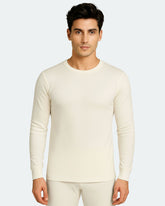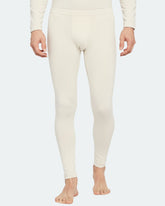Temperature Control Starts with Choosing the Right Base Layer
Winter's chill brings the thrill of outdoor adventures, skiing down snowy slopes, conquering rugged trails, and embracing the cold. But the secret to enjoying these activities lies in the often-overlooked base layer. Thermal wear for women and thermal wear for men is the first line of defense. It manages moisture by wicking sweat away to keep you dry and regulates your body temperature to prevent discomfort.
The ABCs of the base layer are Absorption, Breathability, and Comfort.
A well-chosen base layer effectively absorbs sweat, allows your skin to breathe, and feels like a second skin, ensuring you stay comfortable and safe during winter activities. In this blog, we’ll explore the importance of choosing a suitable base layer, the key qualities to look for in a base layer, and how to select the best one for different winter activities.
Why is the base layer important:

Think of your base layer as your secret weapon against the winter chill. It's like your body's little heater, keeping you toasty warm while you conquer snow-covered mountains or sip hot cocoa by the fire. Without a good base layer, you might end up feeling like a frozen popsicle, and that's just no fun. A good quality base layer offers:
Moisture Control
When you engage in physical activities, even in winter, your body generates sweat to cool down. This sweat can become a problem in cold conditions if it remains on your skin, making you feel chilly and uncomfortable. When sweat evaporates directly from your skin, it leads to a loss of body heat, which can quickly make you cold, especially in frigid conditions. A good base layer wicks moisture away from your skin, transferring it to the outer layers of your clothing where it can evaporate. This process keeps you dry and helps maintain a stable body temperature, preventing that cold, damp feeling that can lead to discomfort or even illness. By allowing evaporation to occur from your clothes rather than your skin, thermals for men and thermals for women keep you warm and comfortable during winter activities.
Temperature Regulation
The base layer is essential for keeping you comfortable in cold weather by managing your body’s temperature. It works by trapping your natural body heat, helping to keep you warm even in chilly conditions. At the same time, it allows excess heat to escape, preventing you from overheating during physical activities. This balance between holding onto warmth and releasing extra heat makes the base layer important in regulating your body’s temperature during winter activities.
Prevents Cold-Related Issues
A suitable base layer is crucial for staying safe and comfortable in cold weather. Combined with mid-layers and outer layers, it helps protect you from serious cold-related issues like hypothermia and muscle stiffness. The base layer plays a vital role by keeping your skin dry and helping regulate your body temperature. This means your body can function properly even in harsh conditions, making winter activities more enjoyable and safer. The right base layer like thermal wear for men and thermals for women can be the difference between having a great time outdoors and facing potential dangers from the cold.
Insulation
While the primary job of a base layer is to manage moisture and regulate temperature, it also offers a bit of insulation. This insulation comes from the ability of the base layer to trap a small amount of warmth close to your skin. Although it's not the primary source of warmth because that's the job of your mid-layers and outer layers, this light insulation helps maintain your body heat, especially when you're not moving much or when the temperature drops quickly. The insulation you get from a base layer can vary based on the material it's made from, which we'll discuss later in the blog.
Reduces Fatigue
When your body has to work extra hard to keep your temperature steady, especially in cold conditions, it uses more energy, making you feel tired faster. This happens because your body constantly uses heat to stay warm, which can drain your energy reserves. However, wearing a well-chosen base layer helps your body maintain a comfortable temperature without having to work as hard. The base layer traps your body heat, keeps you warm, and wicks away moisture, so your body doesn’t have to spend as much energy on temperature regulation.
This means you can conserve more energy for the activities you enjoy, whether skiing, hiking, or just spending time outdoors, allowing you to stay active and feel less tired throughout the day.
Now that you know how the base layer works and why it’s important, let’s look at how to pick the right one based on your needs.
Key Qualities Your Base Layer Should Deliver

Choosing a suitable base layer is essential for staying comfortable and performing well in cold weather. To make sure your base layer does its job effectively, here are some key qualities you should look for:
Breathability
Moisture wicking is one of the most essential features of a base layer. When you’re active, your body produces sweat; if that sweat stays on your skin, it can make you feel cold and uncomfortable. A good base layer is made from materials like merino wool or synthetic fabrics such as polyester, which are great at pulling sweat away from your skin. This helps the sweat evaporate quickly, keeping you dry and warm.
Breathability is how well the base layer allows air to circulate, letting out excess heat and moisture. This is important because, while you want to stay warm, you don’t want to overheat. A breathable base layer helps you maintain a comfortable temperature by allowing sweat and heat to escape, especially during intense activities like skiing or snowboarding.
Insulation
Insulation refers to how well the base layer can keep you warm. While your outer layers handle most of the insulation, your base layer still plays a role. It helps trap body heat close to your skin, especially when the temperature drops. Merino wool is perfect at this because it retains its insulating properties even when it’s wet. Synthetic materials can also provide good insulation, making them a solid choice in cold conditions.
Fit and Comfort
Make sure your base layer fits well. It should fit snugly against your skin but not so tight that it feels restrictive or uncomfortable. This close fit helps the fabric do its job i.e. wicking away sweat and keeping you warm by staying in contact with your body.
Comfort is just as important. You want a base layer that feels soft and smooth against your skin, reducing the risk of itching or irritation. If it’s uncomfortable, it can make your whole day less enjoyable, especially if you’re wearing it for hours.
A good base layer should also move with you. It shouldn’t bunch up or shift around when you’re active. Whether skiing, hiking, or just out for a walk, a well-fitting base layer will stay in place and keep you comfortable.
Lightweight
A lightweight base layer is essential because it allows you to move freely and easily without feeling weighed down. It also makes it easier to layer additional clothing over the top. Lightweight materials often dry faster, which is a big plus if you’re outdoors for extended periods; they won’t add unnecessary bulk, so you can stay agile and comfortable during your activities.
By paying attention to these qualities, you can pick a base layer that keeps you dry, warm, and comfortable, helping you enjoy your winter activities to the fullest. For more details on choosing the perfect base layer, check out our blog on Kosha Base Layers: Thermals Reinvented.
Choosing the Right Base Layer for Different Activities

When choosing the suitable base layer, it's crucial to think about the specific demands of your activities and the conditions you'll encounter. The effectiveness of your base layer hinges on factors like the intensity of your activity, the climate, and how long you'll be outside. Here are the important factors you should consider to help you make the best choice.
Activity Intensity
The intensity of your activity plays a significant role in choosing the suitable base layer. If you’re doing something high-energy, like skiing, snowboarding, or running in cold weather, your body will produce a lot of heat and sweat. In this case, you’ll need a base layer that can handle moisture well and allow air to circulate so your skin stays cool and dry. Materials like synthetic fabrics or merino wool are excellent because they wick away sweat and help regulate your temperature, keeping you dry and comfortable. On the other hand, if you’re planning a lower-intensity activity, like winter hiking or a relaxed walk, you won’t be generating as much body heat. For these situations, a warmer base layer with more insulation is better to keep you cozy.
Climate Conditions
The weather conditions you’ll face are another important factor. In milder winter weather, you might not need a heavy base layer. A lightweight one that’s breathable can be just right for days when it’s cool but not freezing. For example, if you’re out on a chilly day, a thinner base layer will keep you comfortable without making you too hot. However, if you’re heading out into frigid temperatures, you’ll need something with more insulation. Thicker merino wool base layers work well in icy conditions because they trap heat close to your body while allowing sweat to escape.
Duration of Activity
How long you’ll be outside also affects your choice of base layer. If you’re only going to be outside for a short time, you might prioritize comfort and choose something lightweight that keeps you warm without feeling bulky. But if you’re planning to spend several hours outdoors, like on a long hike or a full day of skiing, you’ll want a durable base layer that can keep you consistently warm. Choosing one that manages moisture effectively throughout the day is essential so you stay comfortable even as conditions change.
Fit and Comfort
Fit and comfort are essential no matter what you’re doing. Your base layer should fit snugly against your skin, almost like a second skin, to help wick away moisture and keep you warm. However, it shouldn’t be so tight that it’s uncomfortable or restricts movement. The fabric should feel soft and smooth so it doesn’t cause irritation or chafing, especially if you wear it for a long time. A well-fitting base layer will allow you to move freely and stay comfortable during your activities.
Layering Compatibility
Finally, think about how your base layer will work with the other layers of clothing you’ll wear. It should be easy to wear under mid-layers and outer shells without feeling bulky or restricted. For example, if you plan to wear a fleece mid-layer and a waterproof outer shell, your base layer should fit comfortably underneath. This way, you can stay flexible, warm, and comfortable, no matter how many layers you must wear for the weather.
By considering these factors, you can choose a base layer that meets your needs and ensures you stay comfortable and warm, no matter your winter activity.
Conclusion:
Base layers are the unsung heroes of winter gear. They play a crucial role in maintaining body temperature, wicking away moisture, and providing comfort during outdoor activities. Whether you're hitting the slopes, exploring the wilderness, or simply staying warm on a chilly day, a well-chosen base layer can make a significant difference.
Ready to conquer winter in comfort and style? Look no further than Kosha! Kosha offers a wide range of high-quality merino wool base layers, designed for both men and women. Explore their collection, including the innovative Women's Thermal Leggings made from Merino Wool and Bamboo, and discover the difference a premium base layer can make. Visit Kosha today and be prepared to embrace the magic of winter!





